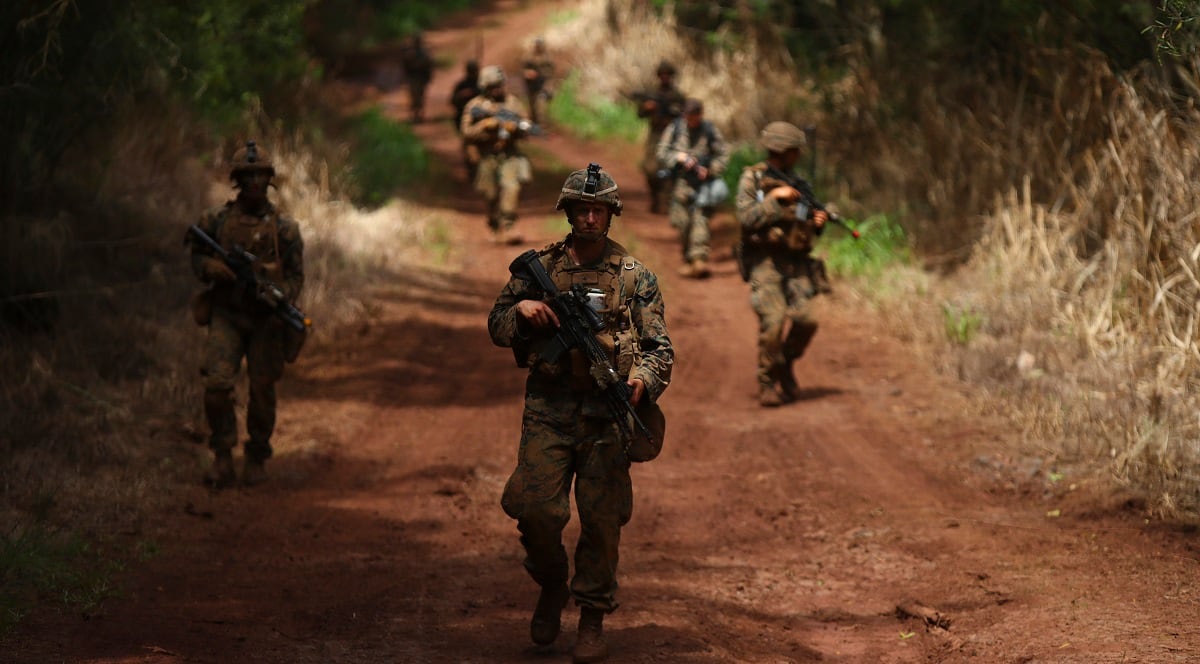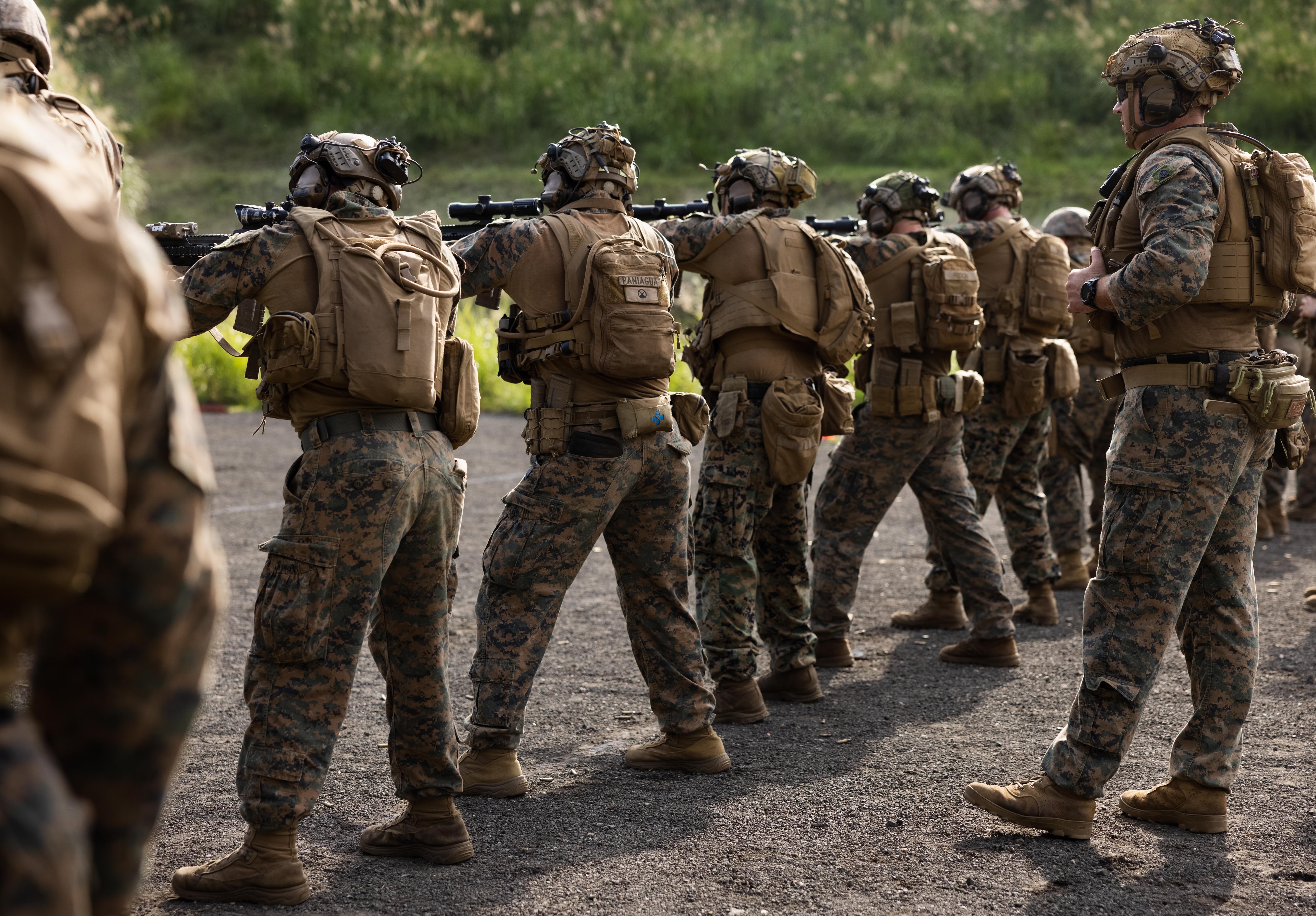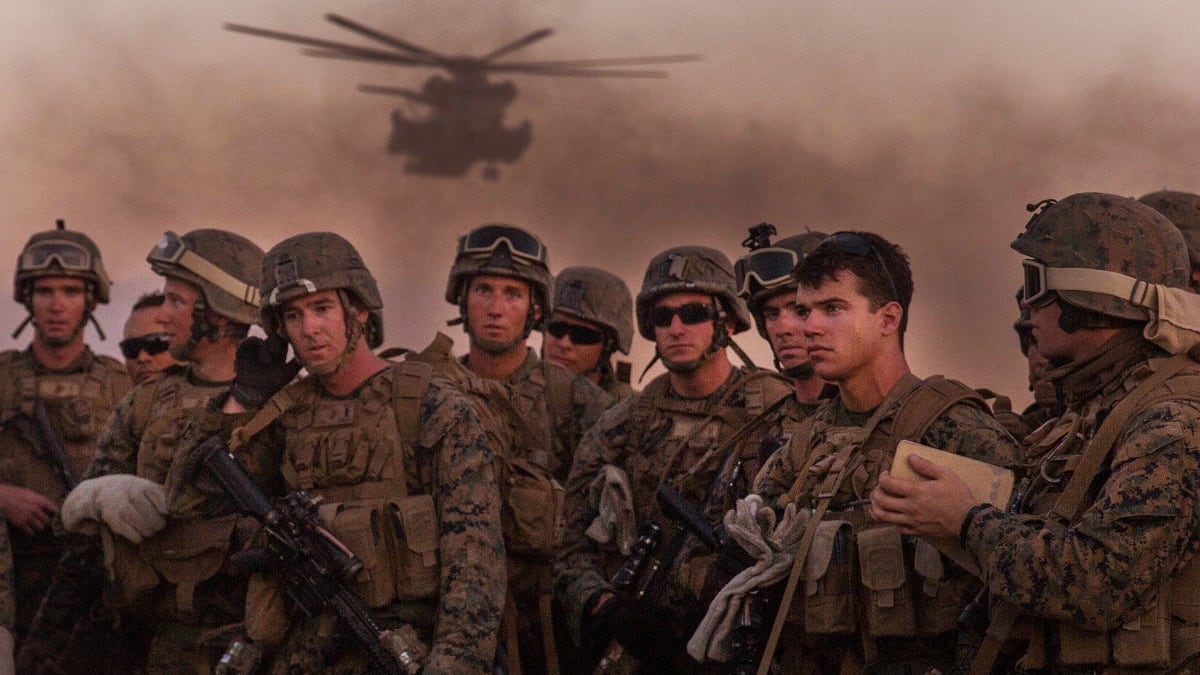A complex new shooting assessment program that requires Marines to be fast, mobile and accurate is rolling out across the Marine Corps, and the infantry community will be the first to be put to the test.
Gone are the days of static target shooting without a time limit. The infantry marksmanship assessment, or IMA, now used primarily at Marine Corps secondary training locations such as Schools of Infantry–East and West, will be the evaluation standard for all grunts within the next five years, according to a new marksmanship campaign plan announced this month by Marine Corps Training and Education Command.
Much of what has been the shooting standard for decades is now out the window in what Marines are calling the biggest change to shooting protocols in more than a century.
The new small arms shooting standard, like the Annual Rifle Qualification introduced in 2021, will have Marines moving, changing positions and hitting realistic human targets under pressure, according to details published by the Marine Corps.
But the “secret sauce,” according to Col. Scott Cuomo, commander of Weapons Training Battalion in Quantico, Virginia, is a tablet-based data collection system that tells Marines not only how accurately they shot, but also how quickly.
Known as the Joint Marksmanship Assessment Program, or JMAP, the device, which was developed by the Naval Health Research Center, creates a digital score sheet that officials say will give Marines a much better picture of how they’ll perform under pressure in combat.
Also gone is the framework that allows Marines to max out their shooting scores. With the IMA/JMAP combo, scores will be tabulated by assessing each round’s proximity to lethal zones on targets that feature human silhouettes, according to videos released by the Marine Corps.
Accuracy scores will be divided by time — the number of seconds it takes to get into position, reload under pressure and put rounds on target, all of which will be tracked by JMAP. The actual scoring classification system has yet to be developed, but it is expected to be finalized by next fall, according to the marksmanship plan.
As described in Marine Corps documents, the IMA, as it will be implemented, consists of the following four courses of fire, totaling 49 rounds in all:
Known Distance Traverse (18 rounds). Three exercises of six rounds each will see Marines firing two rounds at a 100-meter steel target from a supported kneeling position; moving to a barricade-supported position to fire another two shots at a 200-meter target; and then placing weapons on safe while moving into a prone position to the right of the barricade before firing another two shots at a 300-meter target.
Short bay distance (15 rounds). Marines fire five rounds in a standing position, another five rounds in the kneeling position and then move in closer to the targets while speed-reloading to fire the last five rounds from a standing position.
Shooting on the move (6 rounds). Marines fire at two side-by-side targets resembling enemies while continuously on the move. They will fire two shots to the chest of the left target, two to the chest of the right target, conduct a rapid reload and fire one shot each into the heads of each target.
Manipulation and recoil control (10 rounds). In a rapid shooting evolution, Marines will unload six rounds into the chest of a humanoid target, followed by shooting four rounds to the head.
In the marksmanship plan, this high-pressure, combat-simulating shooting strategy is designated by the acronym SPEAR: Speed, Precision, Executive Control, Adaptability and Risk Exposure.
While officials acknowledge risk exposure is likely the toughest element of the group to simulate, it involves many more of the variables than legacy range-qualification assessments, which essentially only evaluated precision.

Cuomo said the changes connect to the combat future Marines envision, in which they’re fighting in smaller elements and at greater distances from each other in an environment like the Indo-Pacific.
“Translated, that means there’s going to be [fewer] Marines and maybe as many of the adversary, or maybe more of the adversary,” Cuomo said. “So, if you really believe these things, then you had better make sure that the Marine is … objectively more lethal with the ammo that you’re giving.”
The present reality, however, is that Marines have been deeply concerned about shooting — and their lacking performance on past battlefields — for years.
As Marine Corps Times reported last year, a 2018 study by Marine Corps Combat Development and Integration exposed glaring gaps, not only in Marines’ shooting performance, but also in what the Corps knew about the effectiveness of its own shooting program.
That study, which sparked the development of JMAP, also spawned a wide-ranging literature review and experimentation.
In 2022, the Corps introduced the Infantry Marksmanship Training Program, or IMTP, for grunts, a new curriculum that represented an early step in embracing battlefield lethality over what officials call “Olympic-style” static shooting.
The results of the new program were astounding.
“[The Office of Naval Research] unequivocally demonstrated that a squad of IMTP-trained [infantry Marine course] graduates would win against a squad of legacy Basic Infantry Marine graduates 99.7 percent of the time,” Cuomo wrote in a newly published Marine Corps Gazette article describing the overhaul.
More changes to the shooting assessment transition, meanwhile, are on the horizon, according to the new campaign plan.

New NMOS
By next spring, Marine marksmanship leaders will draft a new necessary military occupational specialty, or NMOS, a subspecialty job description, for marksmanship instructors specific to the new assessment program.
“There’s nobody trained at scale” to run the new programs, Cuomo said, though he added that the Weapons Training Battalion had just completed a proof-of-concept IMTP instructor course.
To avoid creating a new tasking that will take Marines away from other duties, officials plan to look at ways to consolidate the legacy combat marksmanship and IMTP instruction programs under a single MOS for trainers, he said.
An app for that?
Leaders are also figuring out how to give Marines and their trainers access to the vast wealth of data that JMAP will collect from shooting evaluations.
According to Marine Corps promotional materials, the real-time feedback available through JMAP will help evaluate not only a single Marine’s lethality, but also his or her performance in the context of their squad, unit or company. It will then determine how the element is performing as a whole, allowing commanders to distribute personnel in the most impactful way.
“Part of that is definitely an app on a phone, 100 percent,” Cuomo said.
While shooting data is currently siloed between ranges, with JMAP connected to a tablet for on-the-spot evaluation, the goal is to have a central hub where evaluators, leaders and maybe Marines themselves can get deep into the data.
“The neat thing about that system is you can pull data and compare yourself to every infantry Marine course student that’s ever gone through,” Col. Greg Jones, the retiring former commander of Weapons Training Battalion, told Marine Corps Times.
“You can compare yourself to the Marine Corps shooting team. … Like a Peloton, you can have a ride and get your personal best, and you can compare yourself against everyone else’s personal best.”

Funding questions
The Marine Corps still needs to find a way to pay for all the new JMAP systems, which represent the priciest part of the new shooting program, according to the campaign plan.
The plan gives officials until the end of this year to develop a funding approach for JMAP sustainment at Weapons Training Battalion and the schools of infantry. Additionally, they will have until the first quarter of next calendar year to figure out how to buy JMAP systems for all Marine Corps infantry units by the end of 2025, while formal marksmanship training units will receive them by fall of that year.
While Cuomo wouldn’t say exactly what the systems cost, he likened the total amount needed to the cost the equivalent of a half-dozen amphibious combat vehicles.
Lt. Gen. Benjamin Watson, head of Marine Corps Training and Education Command, demonstrated his confidence that the Corps would find the funding by signing off on the plan, Cuomo said.
Future timeline
While the immediate focus around the new program will be on infantry Marines, signs point toward a service-wide goal of making all Marines proficient in shooting under pressure and in combat-like conditions.
By fiscal 2029, all entry-level Marines should be executing the full Annual Rifle Qualification, rather than the legacy Annual Rifle Training they begin with now, the plan states. This will include range updates to allow Marines to shoot the full ARQ course of fire, including flat 25-meter segments for short-bay drills.
The Rifle Marksmanship Assessment, which closely resembles the IMA, is also on track to become standard for all non-infantry Marines; TECOM is tasked with completing a range analysis by the end of next summer to determine how much it will cost to make that happen.
And while the Marines technically have five years to complete all these taskers, Cuomo emphasized that, in light of an uncertain combat future, they’re motivated to move as fast as they possibly can.
Regarding the tasker of integrating JMAP data and readouts into the existing Marine Corps Training Information Management System, Watson has budgeted three years, Cuomo said, with a deadline of fall 2027.
“That doesn’t mean he wants this to happen three years from now,” Cuomo said. “He would love for this to happen tomorrow.”
Read the full article here
